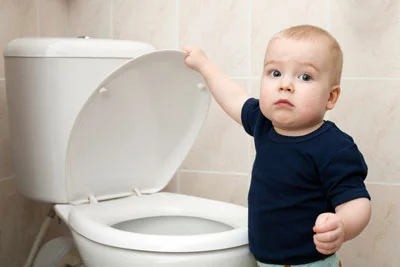When Toilet Learning is NOT Going Well

Part Two in the Toileting Series
You’ve been trying to lead your child to the toilet, but it’s not working – now what? Lynn and I decided to play out a few scenarios for you.
If your child is reluctant to go near a toilet at all…
Do begin simply nudging her toward the bathroom when she needs to have a bowel movement. If you see her squat or head to her favorite spot behind the couch invite her to the bathroom by saying,
“Do you want me to read this story or that one while you go?” Initially you are just getting her into the bathroom. You are not asking her to go near the toilet, much less sit on it. Note, you are also not asking her if she wants to go into the bathroom. You are using a different question that diverts her attention. You can also implement a token system. One M&M for stepping inside the door.
Why? The idea that we urinate and defecate in the bathroom is a foreign concept to children until we teach them. Sometimes the first step to success is simply getting them in the right place. We use a token system because it is an approach that can be helpful when trying to start a new behavior. You give an immediate reward for the desired behavior. The reward is motivational to your child so potential rewards may be M&Ms, pick a prize or a sticker. The key to success with a token system is that once your child has started the behavior, you will stop the token system. And say to him, “Now, I know you can do this. You don’t need tokens anymore. This is what I expect you to do.” If you don’t stop the tokens, your child will likely lose interest in them and you’ll find yourself caught in a cycle of increasing the rewards in an attempt to regain his interest.
If your child is 3.5 years or older and not interested at all in using the toilet and is still using diapers all of the time…
Do put your child on a regular toileting schedule trying to catch him when he’s dry. That may mean checking every 30 minutes or every 90 minutes. The frequency will depend on your child and his bladder control. The key is checking frequently enough to allow him to be successful. At the appointed time you will say to him, “It’s time to try.” Offer a choice. “Do you want me to sing, or read a book while you try?” You can also implement a token system to encourage him to try. Every time he tries he gets one M&M. He doesn’t have to be successful urinating. He’s rewarded for simply trying. If he is successful urinating he gets 2 M&M’s and 3 M&M’s for a bowel movement.
Why? Your goal is to catch him dry so that he has a chance for success. Success builds on success. You use a token system to get a new behavior started. That system ends once the new behavior is learned. You offer choices –(a song or a book) - to divert his attention and avoid a power struggle.
If your child is successful urinating in the toilet, but resists having a bowel movement while on the toilet…
Do let her know she may put on a diaper to go poop. She can pass the movement while in the bathroom with the diaper on. As she begins to go describe the feeling as the poop starts to come out of her body. Allow her to dump the poop out of the diaper into the toilet and flush it. You can gently nudge her toward using the toilet by asking, “Is today a day you want to try sitting on the toilet for pooping or do you want a diaper?” If she says she wants a diaper put it on her, then say, “Maybe next time you’ll be ready to try sitting on the toilet.” One day she will choose to do so. You can further encourage the effort by using the token system. One M&M for trying to poop on the potty and two M&M’s for pooping. In this case you may add the “reward” of using technology (I-Pad, look at photos on a phone, watch a movie) while sitting on the toilet. Doing so allows her to zone out and remain on the toilet long enough for her to relax increasing the odds she’ll be successful. Once she has a couple of successes it will get much easier.
Why? You want to avoid starting a pattern in which your child begins “holding.” (If you see smears in her underwear she’s likely holding.) This can lead to a stretching of the bowel which makes it more difficult to sense the need to go. It can also lead to medical problems. You do not want to force her. Instead you are gently nudging her toward putting her poop in the toilet. Know too that bladder control often occurs months before bowel control.
If your child has been constipated…
Do help your child relax. The brain has a long memory for pain. If your child has suffered painful constipation when he attempts to go, his body may automatically “shut down” to avoid the pain. Offer diversions of listening to a story, singing songs, using electronics to allow him enough time to relax. Use the token system for trying. Serve foods that are easy to digest and pass. Frequently offer water throughout the day. Ensure that he gets outside for exercise.
Why? All of these things can help the bowel movement to “slip out” and the brain to let go of the painful memory.
If your child is afraid of the equipment…
Do create a picture planner for steps moving toward the toilet. It can be as simple as step one – look at the toilet. Step two – step closer to the toilet. Step three – touch the toilet. Step four – sit on the toilet with clothes on. Step five – sit on the toilet without clothes. Step six – flush the toilet. Invite your child to look at the chart. Point out step one and invite him to try. If he resists point out that the chart says that’s what he’s supposed to do. Children believe the chart! A token system can also be effective. One M&M for each step.
Why? You are gently nudging your child toward success. It’s impossible to talk someone out of fear. What does work is breaking a new task or experience into small steps so tiny that each is easily accomplished.
If your child is toilet trained during the day but wets during naps and night time sleep…
Do allow her to wear diapers during sleep.
Why? Day time and night time training are two different things. Often a child has day time control months and sometimes even years before she has night time control. Take the pressure off your child and the frustration of stripping a bed at 3:00 AM off your to do list.
Display All Posts
Search by Topic:
Popular Posts:
- When your child yells at you: Expecting and Coaching respectful behavior
- 5 Tips to Stop the 'Strike out Tantrums:' Hitting, Biting, Kicking and Name-calling
- Why is my child suddenly clingy?
- Ten Steps to a Peaceful Bedtime for Your Spirited Child
- When Your Child’s Meltdowns are Ruining Vacation






